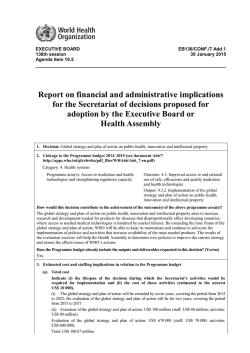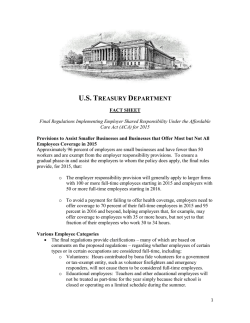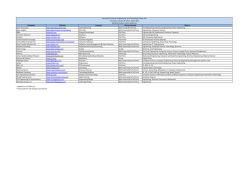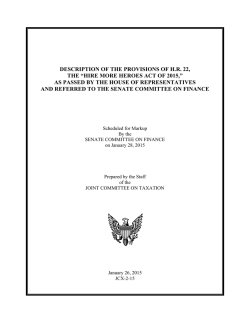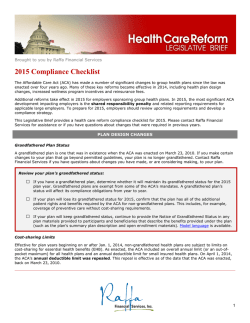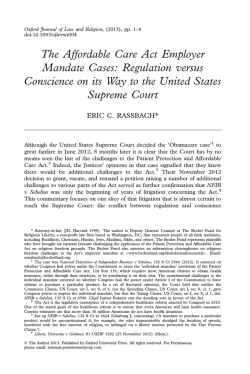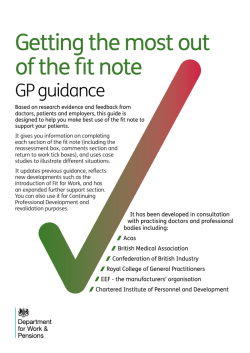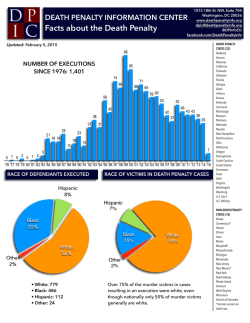
Read the Employer Mandate Fact Sheet
Employer Mandate Fact sheet INFORMED ON REFORM Overview Employers must offer health insurance that is affordable and provides minimum value to their full-time employees and their children up to age 26 or be subject to penalties. This is known as the employer mandate. It applies to employers with 50 or more full-time employees, or full-time equivalents, and will be phased in during 2015 and 2016 based on employer size. Employees who work 30 or more hours per week are considered full-time. This chart shows how the employer mandate will be phased in based on employer size: Employer Size 2015 Plan Year 2016 Plan Year and Beyond 1-49 full-time employees Does not apply Does not apply 50-99 full-time employees* Does not apply Employer must offer coverage to 95% of full-time employees and dependents to age 26 100 or more full-time employees Employer must offer coverage to 70% of full-time employees and dependents to age 26 Employer must offer coverage to 95% of full-time employees and dependents to age 26 * For 2015, these employers will need to certify that they are not reducing the size of their workforce to stay below 100 employees. The employer mandate and employer penalties Employers subject to the employer mandate are required to offer coverage that provides “minimum value” and is “affordable.” The chart below explains these requirements and the penalties that apply if they are not met: Do you offer coverage? No $2,000 per FTE (minus first 30)** applies if one full-time employee receives federal premium subsidy for marketplace coverage. Yes Does the plan provide “minimum value”? (60%+ of total allowed costs) No Lesser of: $3,000 per FTE receiving subsidy or $2,000 per FTE (minus first 30)** Yes Is the coverage affordable? (≤9.5% of income) Yes No penalty 859317c 12/14 No ** For plan years beginning in 2015, the penalty is $2,000 for each full-time employee minus the first 80 employees. For plan years beginning in 2016 and beyond, employers can exclude 30 employees from the penalty calculation. Frequently asked questions Q A Q A How do I determine if my plan provides “minimum value”? A plan provides “minimum value” if it pays at least 60% of the cost of covered services (considering deductibles, copays and coinsurance). HHS has developed a minimum value calculator that can be used to determine if a plan provides minimum value. The minimum value calculator is available at http://www.cms.gov/site-search/search-results.html?q=minimum%20 value%20calculator. How is “affordable” coverage determined? Coverage is considered “affordable” if employee contributions for employee only coverage do not exceed 9.5% of an employee’s household income. There are three safe harbor methods for determining affordability: ›9.5% of an employee’s W-2 wages (reduced for any salary reductions under a 401(k) plan or cafeteria plan) ›9.5% of an employee’s monthly wages (hourly rate x 130 hours per month) ›9.5% of the Federal Poverty Level for a single individual Q A What are the employer mandate requirements for plan years beginning in 2015? For plan years beginning in 2015, employers with 100 or more full-time employees must offer affordable/minimum value medical coverage to 70% of their full-time employees and their dependents to age 26. Employers must treat all employees who average 30 hours a week as full-time employees. Employers who fail to meet the employer mandate will pay a penalty of $2,000 per full-time employee minus the first 80. Some employers will need to expand coverage in 2015 to meet the 70% requirement while others won’t. Examples Assume each employer has 1,000 full-time employees who work at least 30 hours per week. ›Employer 1 currently offers medical coverage to 800 employees who work 40 hours a week. The company meets the requirement to offer coverage to 70% of full-time employees in 2015. ›Employer 2 currently offers medical coverage to 500 full-time employees. The company will need to offer coverage to 200 more full-time employees to meet the 70% requirement. ›Employer 3 has 500 full-time salaried employees who are offered coverage and 500 full-time hourly employees who are not offered coverage. The company will need to offer coverage to at least 200 hourly employees to meet the 70% requirement. ›Employer 4 offers coverage to 700 full-time employees. Only 600 of those employees actually enroll in coverage. The company meets the requirement to offer coverage to 70% of employees. If any full-time employee who is not offered coverage buys coverage through the marketplace and receives a premium subsidy, the employer will pay a $3,000 penalty for each employee who receives a subsidy. Q A How are dependents defined? Dependents include children up to age 26, excluding stepchildren and foster children. Coverage for children must be available through the end of the month in which they reach age 26. Spouses are not considered dependents in the legislation, so employers are not required to offer coverage to spouses. The requirement to offer dependent coverage will not apply in 2015 to employers that are taking steps to add dependent coverage by 2016. 2 Q When do the penalties begin? A The employer mandate penalty for employers with 100 or more full-time employees is effective for the first plan year beginning on or after January 1, 2015. For employers with 50 to 99 employees, the penalty is effective for the first plan year beginning on or after January 1, 2016. Q How will an employer know if a penalty is due? A If a full-time employee receives subsidized coverage through a marketplace, the employer will be notified and given an opportunity to respond before the IRS requires payment of the penalty. Q How do penalties apply to companies with a common owner? A Companies that have a common owner are combined for purposes of determining whether they are subject to the mandate. However, any penalties would be the responsibility of each individual company. Waiting period limitation Employers may not impose enrollment waiting periods that exceed 90 days for all plans, both grandfathered and non-grandfathered, beginning on or after January 1, 2014. Shorter waiting periods are allowed. Coverage must begin no later than the 91st day after the enrollment date. All calendar days, including weekends and holidays, are counted in determining the 90-day period. Examples of employer penalties The employer does not offer coverage to full-time employees The penalty is $2,000 per employee, excluding the first 30 employees.* This example shows how the penalty would be calculated. Employer Trigger Penalty 500 full-time employees No coverage offered 1 employee purchases coverage on the marketplace and is eligible for a federal premium subsidy $2,000 per employee, minus the first 30 employees* 500 – 30 = 470 employees 470 x $2,000 = $940,000 penalty The employer offers coverage that does not meet the minimum value and affordability requirements The penalty is the lesser of the two results, as shown in this example. Employer Trigger Penalty 1,200 full-time employees Employer offers coverage, but coverage is not affordable and/or doesn’t provide minimum value The penalty is triggered if 1 employee purchases coverage on the marketplace and receives a federal premium subsidy 250 employees purchase coverage on the marketplace and are eligible for a subsidy Lesser of $2,000 per employee, minus the first 30 employees* OR $3,000 per employee receiving a federal premium subsidy 1,170 x $2,000 = $2,340,000 penalty 250 x $3,000 = $750,000 penalty (lesser penalty applies) *For plan years beginning in 2015, the penalty is $2,000 for each full-time employee minus the first 80 employees. For plan years beginning in 2016 and beyond, employers can exclude 30 employees from the penalty calculation. 3 Determining how many full-time employees you have Companies will need to determine whether they have 100 or more full-time, or full-time equivalent, employees during the 2014 calendar year. The regulations allow various methods for making this calculation. Because the determination of full-time status can be complex, employers should consult with their legal counsel. Full-time employees work an average of 30 hours per week or 130 hours per calendar month, including › vacation and paid leaves of absence. Part-time employees’ hours are used to determine the number of full-time equivalent employees for › purposes of determining whether the employer mandate applies. The following information can help companies with part-time and seasonal employees determine their number of full-time, or full‑time equivalent, employees. › Only employees working in the United States are counted. ›Volunteer workers for government and tax-exempt entities, such as firefighters and emergency responders, are not considered full-time employees. ›Teachers and other education employees are considered full-time employees even if they don’t work full‑time year-round. ›Seasonal employees who typically work six months or less are not considered full-time employees. This includes retail workers employed exclusively during holiday seasons. ›Schools with adjunct faculty may credit 2 / hours of service per week for each hour of teaching or 1 4 classroom time. ›Hours worked by students in federal or state-sponsored work-study programs will not be counted in determining if they are full‑time employees. “Cigna” and the “Tree of Life“ logo are registered service marks, and “Together, all the way.” is a service mark,of Cigna Intellectual Property, Inc., licensed for use by Cigna Corporation and its operating subsidiaries. All products and services are provided by or through such operating subsidiaries, including Connecticut General Life Insurance Company and Cigna Health and Life Insurance Company, and not by Cigna Corporation. 859317 c 12/14 © 2014 Cigna. Some content provided under license. 4
© Copyright 2026

